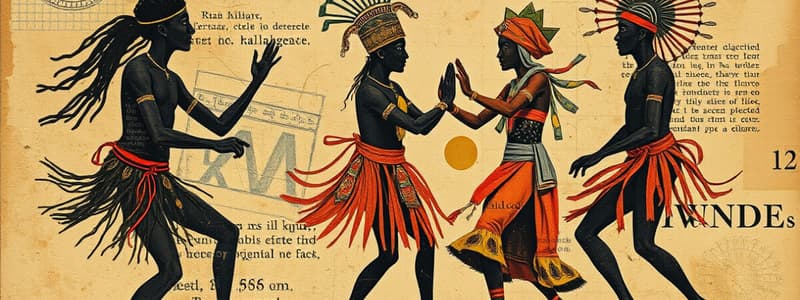Podcast
Questions and Answers
What role did dance primarily serve in ancient Egyptian culture?
What role did dance primarily serve in ancient Egyptian culture?
- Religious expression (correct)
- Social gatherings
- Entertainment
- Military training
How did the ancient Greeks incorporate dance into their society?
How did the ancient Greeks incorporate dance into their society?
- It was only a form of entertainment.
- It was used solely for religious purposes.
- It was integrated into military education for boys. (correct)
- It was taught exclusively to girls.
Which philosophers supported the integration of dance in education in ancient Greece?
Which philosophers supported the integration of dance in education in ancient Greece?
- Plato, Aristotle, and Socrates (correct)
- Socrates and Pythagoras
- Plato and Aristotle only
- Aristotle and Socrates
In what context did dance become brutal and sensationalized in ancient Rome?
In what context did dance become brutal and sensationalized in ancient Rome?
What significant change in the perception of dance occurred during the Roman Empire's later days?
What significant change in the perception of dance occurred during the Roman Empire's later days?
What two types of dance did Plato highlight in his teaching?
What two types of dance did Plato highlight in his teaching?
What did the transition from the Pre-Christian era to ancient Rome signify for dance?
What did the transition from the Pre-Christian era to ancient Rome signify for dance?
What factor contributed significantly to the evolution of dance throughout history?
What factor contributed significantly to the evolution of dance throughout history?
What types of artistic expressions did ancient civilizations focus on alongside dance?
What types of artistic expressions did ancient civilizations focus on alongside dance?
Which statement best characterizes the approach ancient Romans took toward dance?
Which statement best characterizes the approach ancient Romans took toward dance?
Flashcards are hidden until you start studying
Study Notes
Prehistoric Era
- Dance has been a universal aspect across civilizations, rooted in intercultural exchanges.
- Origins trace back to prehistoric times, intertwined with artistic, religious, and social developments.
Pre-Christian Era
- Knowledge of dance emerged within ancient Mediterranean and Middle Eastern civilizations, particularly in Egypt.
- Ancient Egyptian dance is documented through wall paintings and hieroglyphs, serving primarily as religious expression.
Ancient Greeks
- Dance was highly regarded, interconnected with various life experiences, and incorporated into education and military training in Athens and Sparta.
- Greek philosophers, including Plato, Aristotle, and Socrates, championed dance as essential for integrating body and soul.
- Plato emphasized two dance types in his "Laws": noble (honorable) and ignoble (mean or ugly).
Ancient Rome
- The significance of dance diminished as Rome became wealthy; artistic expression waned.
- Dance devolved into violent and sensational forms, often performed by enslaved people, losing its cultural value.
- Resulting moral decay linked dance with early Christian condemnation in the dying days of the Roman Empire.
Christian Era
- The rise of the Catholic Church post-Rome shifted the trajectory of dance history, establishing it as a custodian of learning and morals.
- The church initially prohibited theatrical entertainment but allowed dance within religious ceremonies.
- Christian leaders sanctioned dance when aligned with sacred intentions, incorporating it into worship and church services.
Studying That Suits You
Use AI to generate personalized quizzes and flashcards to suit your learning preferences.




